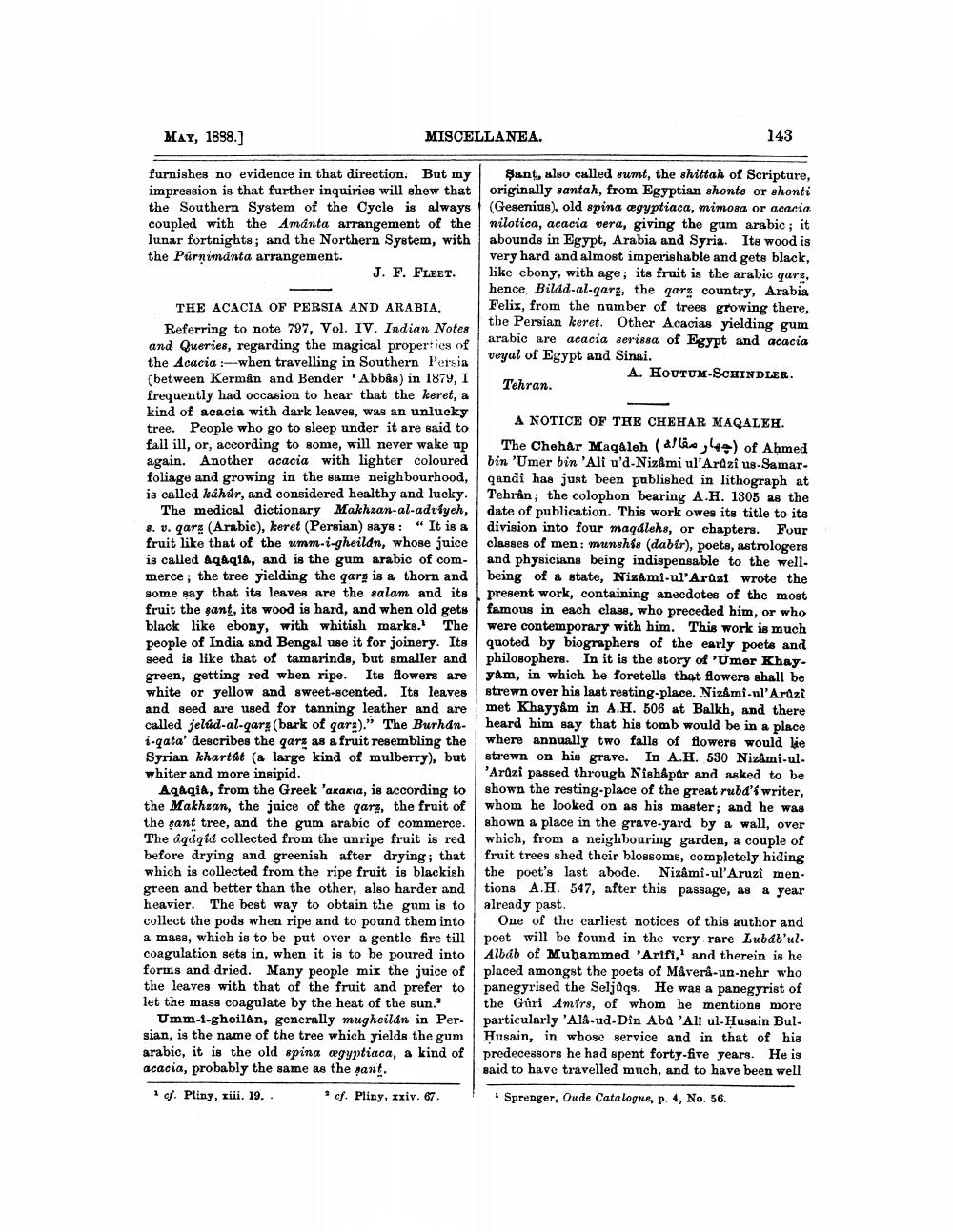________________
MAY, 1898.]
MISCELLANEA.
143
furnishes no evidence in that direction. But my impression is that further inquiries will ghew that the Southern System of the Cycle is always coupled with the Amánta arrangement of the lunar fortnights; and the Northern System, with the Purnimanta arrangement.
J. F. FLEET.
Şant, also called sumt, the shittah of Scripture, originally santah, from Egyptian shonte or shonti (Gesenius), old spina ægyptiaca, mimosa or acacia nilotica, acacia vera, giving the gum arabic; it abounde in Egypt, Arabia and Syria. Its wood is very hard and almost imperishable and gets black, like ebony, with age; its fruit is the arabic qars, hence Bildd-al-qara, the qarz country, Arabia Felix, from the number of trees growing there, tbe Persian keret. Other Acacias yielding gum arabic are acacia serissa of Egypt and acacia veyal of Egypt and Sinai.
A. HOUTUM-SCHINDLER. Tehran.
THE ACACIA OF PERSIA AND ARABIA. Referring to note 797, Vol. IV. Indian Notes and Queries, regarding the magical properties of the Acacia :-when travelling in Southern Persin (between Kerman and Bender 'Abbas) in 1879, I frequently had occasion to hear that the keret, a kind of acacia with dark leaves, was an unlucky tree. People who go to sleep under it are said to fall ill, or, according to some, will never wake up again. Another acacia with lighter coloured foliage and growing in the same neighbourhood, is called kahúr, and considered healthy and lucky.
The medical dictionary Makhzan-al-adriyeh, 9. v. gare (Arabic), keret (Persian) says: “It is a fruit like that of the umm-i-gheildn, whose juice is called aqaqia, and is the gum arabic of com- merce; the tree yielding the qarz is a thorn and some say that its leaves are the salam and its fruit the şant, its wood is hard, and when old gets black like ebony, with whitish marks. The people of India and Bengal use it for joinery. Its geed is like that of tamarinds, but smaller and green, getting red when ripe. Its flowers are white or yellow and sweet-scented. Its leaves and seed are used for tanning leather and are called jelúd-al-qarz (bark of qarz)." The Burhan. i-qata' describes the qarz as a fruit resembling the Syrian khartat (a large kind of mulberry), but whiter and more insipid.
Aqaqia, from the Greek 'akakta, is according to the Makhzan, the juice of the qarz, the fruit of the sant tree, and the gum arabic of commerce. The aqaqid collected from the unripe fruit is red before drying and greenish after drying; that which is collected from the ripe fruit is blackish green and better than the other, also harder and heavier. The best way to obtain the gun is to collect the pods when ripe and to pound them into a mass, which is to be put over a gentle fire till coagulation sets in, when it is to be poured into forms and dried. Many people mix the juice of the leaves with that of the fruit and prefer to let the mass coagulate by the heat of the sun.'
Umm-1-gheilan, generally mugheilan in Persian, is the name of the tree which yields the gum arabic, it is the old spina ægyptiaca, a kind of acacia, probably the same as the sant. 1 cf. Pliny, xiii. 19.
cf. Pliny, xxiv. 67.
A NOTICE OF THE CHEHAR MAQALEH. The Chehar Maqaleh (alle, e) of Ahmed bin 'Umer bin 'Ali u'd-Nizami ul'Ardzi us-Samarqandt has just been published in lithograph at Tehrân; the colophon bearing A.H. 1305 as the date of publication. This work owes its title to its division into four maqdlehs, or chapters. Four classes of men : munshss (dabir), poets, astrologers and physicians being indispensable to the wellbeing of a state, Nizami-ul'Arůzt wrote the present work, containing anecdotes of the most famous in each class, who preceded him, or who were contemporary with him. This work is much quoted by biographers of the early poets and philosophers. In it is the story of 'Umer Khayyam, in which he foretells that flowers shall be strewn over his last resting-place. Nizami-ul'Ardzi met Khayyam in A.H. 506 at Balkh, and there heard him say that his tomb would be in a place where annually two falls of flowers would lie strewn on his grave. In A.H. 530 Nizami-ul. 'Arazi passed through Nish&par and asked to be shown the resting place of the great rubd'i writer, whom he looked on as his master; and he was shown a place in the grave-yard by a wall, over which, from a neighbouring garden, a couple of fruit trees shed their blossoms, completely hiding the poet's last abode. Nizâmi-ul'Aruzi mentions A.H. 547, after this passage, as a year already past.
One of the carliest notices of this author and poet will be found in the very rare Lubab'ul. Albáb of Muhammed 'Arifi, and therein is he placed amongst the poets of Mavera-un-nehr who panegyrised the Seljaqs. He was a panegyrist of the Guri Amirs, of whom he mentions more particularly 'Ald-ud-Din Aba 'Ali ul-Husain Bul. Husain, in whose service and in that of his predecessors he had spent forty-five years. He is said to have travelled much, and to have been well
*Sprenger, Oude Catalogue, p. 4, No. 56.




